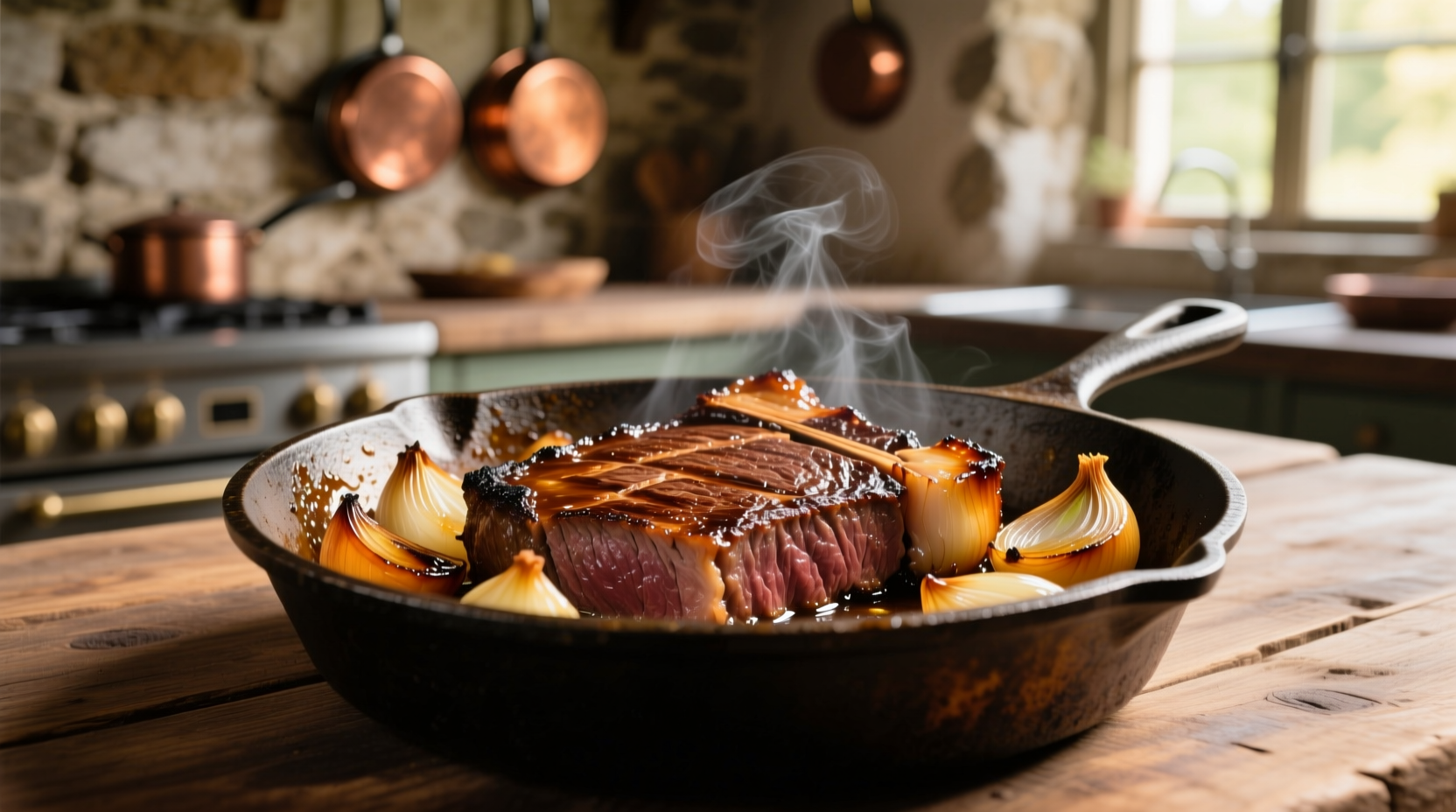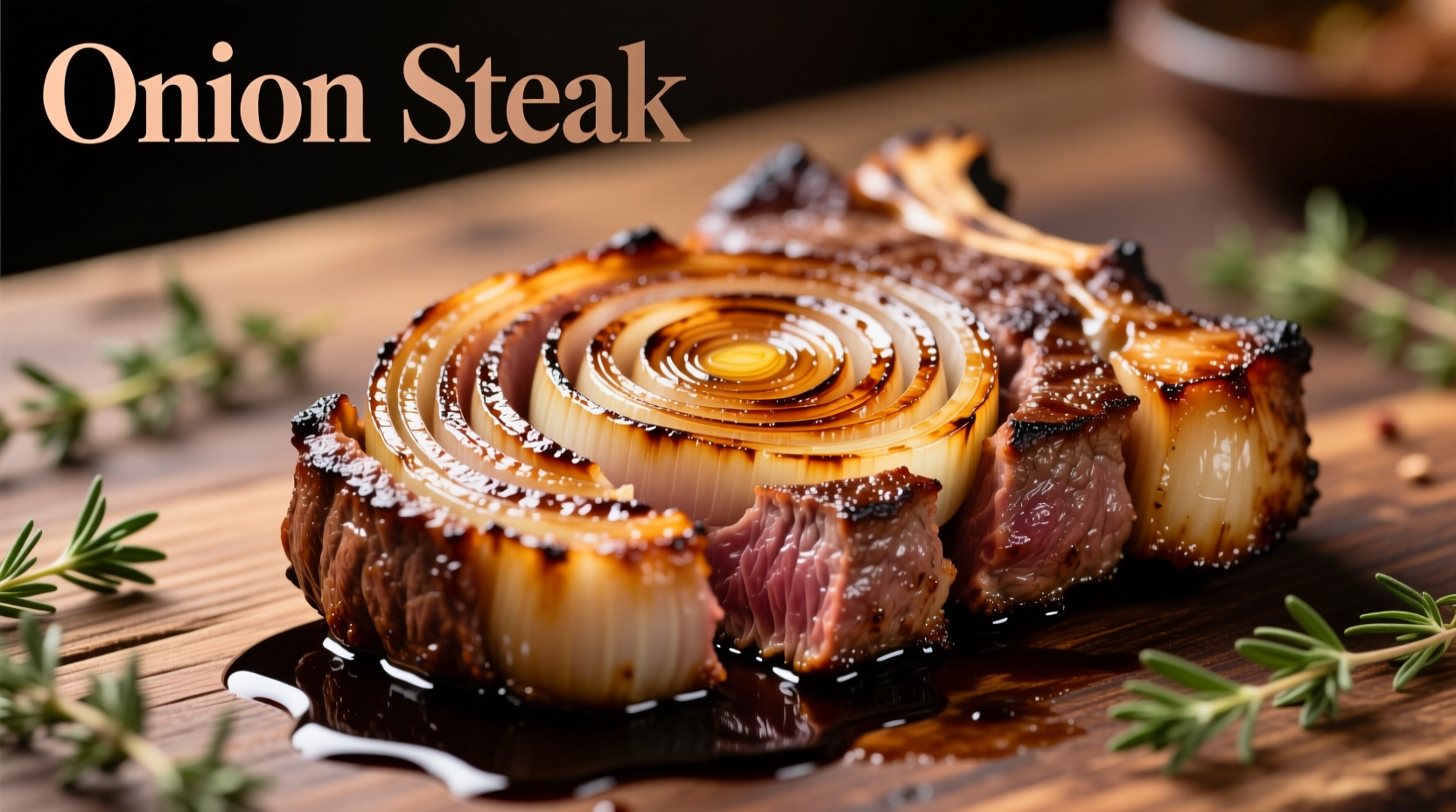Discover how to transform humble onions into a show-stopping dish that even meat lovers will crave. This comprehensive guide reveals the professional chef techniques for creating perfectly caramelized onion steaks with that coveted meaty texture and deep umami flavor profile. Whether you're exploring plant-based alternatives or simply want to elevate your vegetable game, mastering onion steak preparation delivers restaurant-quality results at home.
What Exactly Is Onion Steak?
Despite its name, onion steak contains no meat whatsoever. It refers to a specific preparation method where large onions—typically sweet varieties—are sliced horizontally into ½ to 1-inch thick rounds that maintain their structural integrity during cooking. When properly caramelized, these "steaks" develop complex flavors through the Maillard reaction and natural sugar concentration, creating a surprisingly meat-like texture and umami depth.
The technique has evolved from simple caramelized onions to a standalone preparation method popularized by chefs seeking vegetarian "center of the plate" options. Food science explains why this works: as onions cook slowly, their natural sugars caramelize while sulfur compounds transform, reducing pungency and developing rich, savory notes that mimic meat flavors.
Selecting the Perfect Onion Varieties
Not all onions work equally well for this technique. Your success depends heavily on choosing the right variety with sufficient size and sugar content. Here's how different onions perform:
| Onion Type | Best For Onion Steak? | Sugar Content | Texture After Cooking |
|---|---|---|---|
| Vidalia | Excellent | 12-14% | Buttery, tender with firm structure |
| Walla Walla | Excellent | 11-13% | Rich caramelization, holds shape well |
| Yellow Storage | Good | 8-10% | Firm texture but requires longer cooking |
| Red Onion | Fair | 7-9% | Tends to fall apart, more acidic flavor |
| Shallot | Poor | 10-12% | Too small, lacks structural integrity |
According to USDA nutritional data, sweet onions contain approximately 4-5% more natural sugars than standard yellow onions, which directly impacts caramelization potential. For best results, select onions that are 3-4 inches in diameter with tight, dry skins and no soft spots.
Cutting Technique: Creating Structurally Sound Onion Steaks
The cutting method determines whether your onion will hold together as a "steak" or fall apart into rings. Follow these professional steps:
- Remove only the papery outer skin while keeping root end completely intact
- Place onion on cutting board with root end facing away from you
- Using a sharp chef's knife, slice horizontally through the onion parallel to the cutting board
- Cut ½ to 1-inch thick slices, maintaining the root structure that holds layers together
- For larger onions, you'll get 3-4 perfect "steaks" from the center sections
The root end's fibrous structure acts as natural "glue" that keeps the onion steak intact during cooking. Never remove the root end completely—this is the chef's secret for maintaining structural integrity. If your onions keep falling apart, you're likely cutting too close to the root or using varieties with insufficient sugar content.

Mastering the Cooking Process: Three Professional Methods
Professional kitchens use three primary methods for preparing onion steak, each with distinct advantages:
Pan-Searing Method (Most Popular)
This technique delivers the deepest caramelization and best texture control:
- Preheat heavy skillet (cast iron preferred) over medium-low heat for 5 minutes
- Add 1 tablespoon high-smoke point oil (avocado or grapeseed)
- Place onion steaks in single layer without crowding
- Cook undisturbed for 15-20 minutes until deeply caramelized
- Flip carefully using thin spatula and cook additional 10-15 minutes
- Finish with splash of balsamic vinegar or soy sauce for umami boost
Grilling Method (Summer Favorite)
Ideal for outdoor cooking with smoky flavor infusion:
- Preheat grill to medium heat (350-400°F)
- Brush onion steaks with olive oil and season
- Place directly on grill grates
- Cook 8-10 minutes per side with lid closed
- Rotate 90 degrees halfway through for attractive grill marks
Oven Roasting Method (Hands-Off Approach)
Best for consistent results with minimal attention:
- Preheat oven to 400°F with rack in center position
- Arrange onion steaks on parchment-lined baking sheet
- Drizzle with oil and season
- Roast 25-30 minutes until deeply caramelized
- Flip halfway through cooking process
Flavor Enhancement Strategies
Elevate your onion steak from simple side dish to centerpiece with these professional flavor techniques:
- Umami Boosters: Add ½ teaspoon soy sauce or tamari during last 5 minutes of cooking
- Acid Balance: Finish with splash of sherry vinegar or lemon juice to cut richness
- Herb Infusion: Toss fresh thyme or rosemary sprigs into the pan during cooking
- Spice Layering: Sprinkle with smoked paprika before cooking for depth
- Sweet Counterpoint: Drizzle with maple syrup during final caramelization phase
Food science reveals that adding a small amount of acid (like vinegar) during the final cooking stage actually enhances caramelization by breaking down complex sugars into simpler, more reactive forms. This professional trick creates deeper flavor development without burning.
Common Problems and Professional Solutions
Even experienced cooks encounter these challenges when preparing onion steak. Here's how to solve them:
- Problem: Onion steaks falling apart during cooking
Solution: Ensure root end remains completely intact and use sweet onion varieties with higher sugar content - Problem: Uneven cooking with burnt edges
Solution: Cook over medium-low heat and cover pan with lid for first 10 minutes to steam onions slightly - Problem: Excessive moisture preventing caramelization
Solution: Pat onion steaks dry before cooking and avoid overcrowding the pan - Problem: Lack of meaty texture development
Solution: Extend cooking time at lower temperature to fully concentrate flavors
Serving Suggestions and Culinary Applications
While delicious on their own, onion steaks shine when incorporated into complete dishes:
- As a vegetarian "steak" alternative served with mushroom gravy
- Layered in sandwiches or burgers for meaty texture
- Chopped and added to risotto for intense umami flavor
- Served alongside roasted meats as a sophisticated side
- Thinly sliced raw onion steak in salads for mild onion flavor
Professional chefs note that properly prepared onion steak contains approximately 30% less moisture than raw onions while concentrating natural sugars by nearly 400%, creating that distinctive meaty texture through structural transformation rather than added ingredients.
When Onion Steak Works Best (And When It Doesn't)
This technique has specific context boundaries that determine success:
- Ideal for: Sweet onion varieties during peak season (spring through early summer)
- Works well: As a vegetarian main course component or sophisticated side dish
- Limited success: With small onions or varieties high in sulfur compounds
- Avoid when: Cooking for large groups (time-intensive per serving)
- Not suitable: As a direct meat substitute in recipes requiring protein structure
Understanding these context boundaries prevents disappointment and helps you apply the technique where it delivers maximum impact. The method shines brightest when treated as its own culinary preparation rather than a meat imitation.











 浙公网安备
33010002000092号
浙公网安备
33010002000092号 浙B2-20120091-4
浙B2-20120091-4